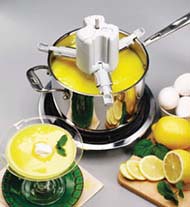Weekend Herb Blogging #17 - Wild Bay
The California bay laurel, Umbellaria californica, grows in wild profusion in my part of the California Wine Country (as elsewhere, I'm sure). These are not the "true" laurel, Laurus nobilis, but their leaves can be used in cooking.
Dry them as you would true laurel and add them to soups or stews. Although the flavor is very similar, these leaves are much stronger than their "noble" relative. Use about half what you would of true laurel. For example, one leaf in a large pot of flageolet beans is plenty. If you have access to California bay leaves, experiment with them, to see how much is palatable for you.
Lightly Pickled Veggies
I wish I could remember the proper name for these, but I don't. I got the recipe from a Guatemalan friend I worked with at UCSF. They’re lovely and light as part of a hot weather buffet or snack tray. Berta used to make a huge batch for her annual entertaining the coworkers party, and they vanished with amazing speed. They’re cooked only long enough to give them a little pickle flavor. They should definitely still have their crunch.Ingredients:
- Baby carrots or carrot sticks
- Cauliflower, broken into florets
- Salsify, cut in pieces to match the carrots
- Celery sticks
- Green onions
- Water, enough to let the veggies move around without crowding
- Bay leaf
- White vinegar
- Salt
- Sugar
- Peppercorns
Preparation:
- Put the water, bay leaf and peppercorns in a large enough pan to give the veggies room to move around. Set it over medium heat.
- While the water is heating, wash all the veggies and drain.
- Cut the tops off the green onions about an inch above the white, just enough to give them a flare of green, and remove the root end.
- When the water is warmed, begin adding vinegar, salt and sugar, tasting as you go until you like the acid/salt/sugar balance – it should be a little tart. As a starting point, if you used a gallon of water, start with a cup of vinegar. Add the salt and sugar by pinches – it’s easy to get too much.
- Add the solid ingredients, like carrots, caulilflower and salsify, first. Don’t let the mixture boil; just keep it at a simmer (just below a boil)
- After 15 minutes, add the green onions and celery. Simmer for an additional 10 minutes.
- Remove veggies from the liquid with a slotted spoon and let cool to room temperature. You can chill them if you like. They keep well in the refrigerator for at least a week in their cooking liquid, but they will be come more strongly flavored.
Leftovers – if you have any of these veggies left over, which I doubt, you can slice them up in a salad for nice bits of zingy flavor.
Caution: It's probably best not to pick leaves from roadside trees or trees on public lands, unless you can ascertain that they haven't been sprayed, making them toxic and not fit for food use.



